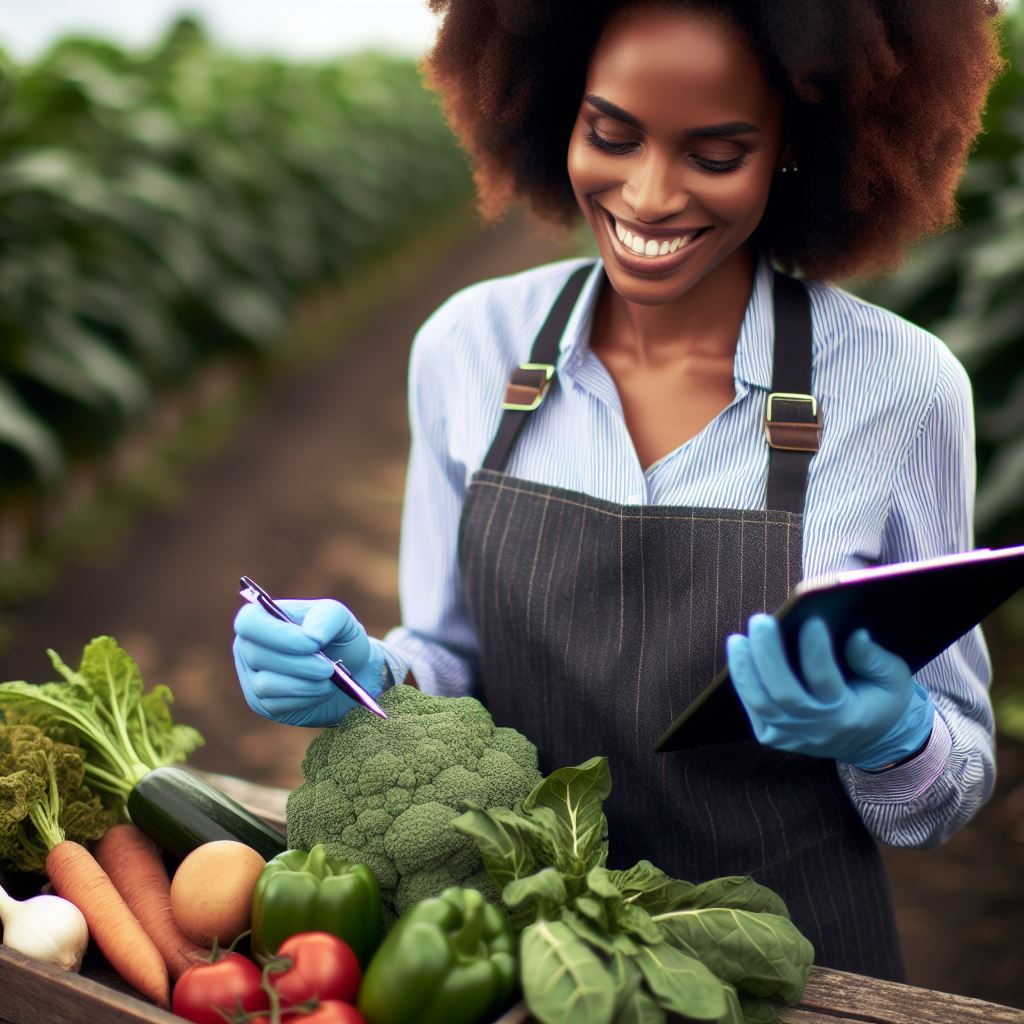Food’s Journey: Ensuring Quality & Safety
Last Updated on January 26, 2024
Introduction
The Food Journey Quality and Safety hold paramount significance in safeguarding the well-being and health of individuals.
In recent times, there have been several incidents raising concerns and highlighting the significance of food safety.
From contaminated produce to foodborne illnesses, the consequences of compromised food quality can be severe.
Therefore, it is crucial to implement measures that guarantee the provision of safe and high-quality food.
The quality of food starts at the source, with farmers and producers upholding certain standards and regulations.
Monitoring and enforcing these standards throughout the supply chain is vital to maintaining food safety.
Stringent inspections and testing should be conducted at every stage, from harvest to processing and distribution.
Additionally, proper labeling and transparency about ingredients, allergens, and potential contaminants can further enhance food safety.
Adopting technology, such as blockchain, can improve traceability and accountability in the food industry.
Regular and comprehensive training of food handlers and workers is another crucial aspect of ensuring food safety.
Adhering to proper hygiene practices, such as frequent handwashing and maintaining clean and sanitized facilities, is essential.
Public awareness campaigns can also play a significant role in educating individuals about the importance of food safety.
By prioritizing food quality and safety, we can safeguard public health, reduce the risk of illness, and promote overall well-being.
Understanding the Journey of Food
Various stages involved in the journey of food
- During the production and farming stage, crops are grown and animals are reared for food.
- Next, the food goes through the processing and packaging stage, where it is transformed and prepared for consumption.
- Once processed, the food moves on to the distribution and transportation stage, where it is transported to various locations.
- Finally, at the retail and consumption stage, the food reaches the consumer and is either prepared at home or consumed at restaurants.
Potential risks and challenges at each stage
Production and farming
In this stage, the quality and safety of food heavily rely on agricultural practices.
Factors such as the use of pesticides and fertilizers, animal welfare, and genetic modifications can impact food quality.
Farmers face challenges such as pests, diseases, and weather conditions, which can affect crop yields and animal health.
Processing and packaging
The processing stage involves various techniques like washing, cutting, and preserving food.
The challenge here is to maintain cleanliness and prevent contamination.
Packaging plays a crucial role in preserving the quality and safety of food, but inadequate packaging can lead to spoilage.
Distribution and transportation
Distribution involves moving food from processing facilities to warehouses, stores, or restaurants.
Temperature control and proper handling are essential to prevent spoilage and foodborne illnesses.
Transportation challenges include maintaining appropriate temperature conditions and ensuring timely delivery, especially for perishable goods.
Retail and consumption
At the retail stage, food must be properly stored and displayed to maintain its quality.
Retailers must follow hygiene practices and comply with food safety regulations.
Consumers face risks related to mishandling or improper cooking of food, which can result in foodborne illnesses.
The journey of food involves several stages, each with its own set of risks and challenges.
From production to consumption, it is crucial to ensure quality and safety at every step.
By understanding these stages and addressing the associated risks, we can contribute to a safer and more reliable food supply chain.
Read: Farm to Table: The Transparency Revolution
Ensuring Quality in Food Production
Importance of Good Agricultural Practices
- Good agricultural practices are essential to ensure the quality and safety of our food.
- These practices involve responsible use of resources, such as water and soil, to maintain sustainability.
- Implementing proper crop rotation and integrated pest management helps reduce the use of harmful chemicals.
- By following good agricultural practices, farmers can produce nutritious crops while protecting the environment.
- It is crucial to educate and train farmers in these practices to promote a sustainable and safe food production system.
Sustainable Farming Methods
- Sustainable farming methods focus on minimizing the negative impact on the environment and maximizing productivity.
- Organic farming, for example, avoids the use of synthetic chemicals and genetically modified organisms (GMOs).
- Sustainable farmers prioritize soil health through practices like composting and crop diversification.
- Conservation tillage techniques minimize soil erosion and help retain moisture, enhancing overall crop quality.
- These methods not only ensure food safety but also support biodiversity and ecosystem preservation.
The Need for Proper Handling of Chemicals, Fertilizers, and Pesticides
- Chemicals, fertilizers, and pesticides used in food production require proper handling to prevent contamination.
- Strict adherence to labeling, dosage, and storage instructions is crucial to maintaining food quality and safety.
- Farmers must undergo training on safe handling practices to minimize the risk of chemical residues in food.
- Regular testing for pesticide residues is essential to ensure compliance with safety standards and protect consumers.
- Responsible use of these substances reduces potential harm to the environment and human health.
The Role of Technology in Enhancing Food Quality during Production
- Technology plays a vital role in improving food quality and safety throughout the production process.
- Advanced machinery helps automate tasks, increasing efficiency and reducing human error.
- Monitoring systems enable real-time tracking of production parameters, ensuring quality control.
- Technology aids in precision agriculture, allowing farmers to optimize resource usage and minimize waste.
- From sensor-based irrigation systems to automated sorting and grading, technology enhances food quality and productivity.
Essentially, ensuring quality in food production is crucial for both the well-being of consumers and the sustainability of our planet.
Good agricultural practices, sustainable farming methods, proper handling of chemicals, and the integration of technology all contribute to achieving this goal.
By implementing these measures, we can maintain the quality, safety, and nutritional value of our food, while also protecting the environment and promoting a more sustainable future.
Read: Local Food Trends: From Farmer’s Field to You
Maintaining Safety during Processing and Packaging
The necessity of hygienic processing practices
Food safety is paramount, and hygienic processing practices are essential to ensure the quality of our food.
Contamination from pathogens can occur during processing if hygiene is not prioritized.
To ensure food safety, processing facilities must maintain clean working environments and regularly disinfect equipment.
Proper cleaning procedures, such as using hot water and approved sanitizers, should be followed to prevent cross-contamination.
Regular employee training on hygienic practices is crucial to minimize the risk of foodborne illnesses.
Importance of equipment maintenance and sanitation
Equipment used in food processing should be regularly maintained and sanitized to prevent contamination.
Regular inspection of equipment ensures that it functions properly and minimizes the risk of potential hazards.
Cleaning and sanitization processes should be documented and followed meticulously.
A clean and sanitized processing area prevents the growth of bacteria, molds, and other harmful microorganisms.
Well-maintained equipment reduces the risk of physical contamination and maintains the quality of food products.
Significance of quality control measures
Implementing quality control measures is vital to ensure the safety and quality of processed and packaged food.
Quality control includes monitoring the entire production process, from raw material sourcing to final packaging.
Regular inspections and testing for microbial contamination, chemical residues, and physical hazards should be carried out.
Prompt action must be taken if any deviations from quality standards are detected to prevent compromised food safety.
By maintaining strict quality control measures, food processors can ensure that consumers receive safe and high-quality products.
The role of certifications and regulatory bodies in ensuring food safety
Certifications and regulatory bodies play a crucial role in maintaining food safety standards.
Certifications, such as Hazard Analysis and Critical Control Points (HACCP), indicate adherence to rigorous safety protocols.
Regulatory bodies, such as the Food and Drug Administration (FDA), enforce regulations to protect public health.
These certifications and regulatory bodies conduct regular inspections to ensure compliance with food safety regulations.
Through their oversight and enforcement, they hold food processors accountable for maintaining safety and quality.
In general, maintaining safety during food processing and packaging is crucial to ensure the quality of our food.
Hygienic processing practices, equipment maintenance and sanitation, quality control measures, and certifications all contribute to food safety.
By prioritizing these aspects, we can be confident in the products we consume and minimize the risk of foodborne illnesses.
Read: Organic Eats: Beyond the Label in Farming

Safeguarding Quality throughout Distribution and Transportation
The need for temperature control and monitoring
Temperature control and monitoring play a crucial role in ensuring the quality and safety of food products during distribution and transportation.
Maintaining the appropriate temperature is essential to prevent spoilage, contamination, and the growth of harmful microorganisms.
One of the main reasons for maintaining temperature control is to prevent bacterial growth.
Many foodborne illnesses are caused by bacteria that multiply rapidly in the temperature danger zone, which ranges from 40°F to 140°F (4°C to 60°C).
By keeping the food products below or above this temperature range, the growth of bacteria can be effectively controlled.
In addition to bacteria, enzymes present in food can also cause spoilage and quality deterioration if not properly controlled.
Enzymatic activity is dependent on temperature, and certain enzymes can become more active at higher temperatures, leading to undesirable changes in the food’s texture, flavor, and appearance.
To ensure temperature control, several measures can be implemented.
Refrigerated trucks and containers equipped with temperature monitoring devices are commonly used to transport perishable goods.
These devices continuously record and display the temperature inside the storage area, allowing for real-time monitoring and adjustment.
Furthermore, the use of insulated packaging and temperature-controlled compartments can help maintain the desired temperature.
Ice packs, dry ice, and thermal blankets are some of the tools used to regulate temperature during transportation.
Addressing the challenges associated with long-distance transportation
Long-distance transportation presents unique challenges in safeguarding the quality of food products.
The longer the travel time, the higher the risk of quality deterioration due to temperature fluctuations, mechanical vibrations, and exposure to light and humidity.
Temperature fluctuations can occur when goods are transported across different climate zones or during unloading and reloading processes.
These fluctuations can compromise the quality and safety of the food products.
To mitigate this risk, careful planning and coordination are necessary to minimize the time spent outside the recommended temperature range.
Another challenge is the mechanical vibrations during transportation.
Vibrations can cause physical damage to the food products, leading to bruising, breakage, or leakage.
Fragile items, such as fruits and vegetables, should be properly packed and secured to minimize the impact of vibrations.
Exposure to light and humidity can also affect the quality of food products.
Light can accelerate the degradation of certain nutrients, vitamins, and flavors. Humidity can lead to mold growth, spoilage, and loss of crispness in products like biscuits and cookies.
It is essential to use appropriate packaging materials that provide protection against light and moisture.
Traceability systems and their importance in ensuring quality
Traceability systems are crucial in the food industry to track and monitor the movement of products along the supply chain.
They provide transparency and accountability, ensuring that food products can be traced back to their origin and verified for quality and safety.
Traceability systems enable quick and efficient identification of the source of any potential food safety issues or quality defects.
In case of a recall or contamination incident, tracing the affected products becomes easier, allowing for targeted actions to be taken to prevent further harm.
Furthermore, traceability systems facilitate compliance with food regulations and standards.
They help verify whether the food products meet the required quality specifications, such as labeling claims, ingredients, and allergen declarations.
Implementing traceability systems involves the use of various technologies, including barcodes, QR codes, RFID tags, and electronic data interchange (EDI).
These technologies enable the collection, storage, and retrieval of critical information related to the movement and handling of food products.
Impact of packaging and storage conditions on food safety
Proper packaging and storage conditions are essential in maintaining the quality and safety of food products during distribution and transportation.
Packaging serves as a protective barrier against physical, chemical, and biological hazards.
It helps prevent contamination from external sources, such as dust, pests, and microorganisms.
Packaging also plays a vital role in preserving the freshness, flavor, and nutritional value of the food products.
Choosing the right packaging material is crucial to ensure the safety and quality of the products.
For example, perishable items may require moisture-resistant packaging to prevent spoilage.
On the other hand, oxygen-sensitive products, such as certain fruits and vegetables, may require packaging with modified atmosphere properties to extend their shelf life.
Storage conditions, both during transportation and in distribution centers, also impact food safety.
Improper storage temperatures can lead to the growth of bacteria, mold, and other microorganisms.
It can also accelerate the deterioration of products, causing quality issues and potential health risks.
By maintaining proper temperature, humidity, and ventilation, food products can be stored safely and maintain their quality for extended periods.
Regular monitoring of storage conditions and proper handling practices are necessary to prevent deviations that could compromise the safety and quality of the food products.
In essence, ensuring quality throughout the distribution and transportation of food products requires strict temperature control, addressing challenges associated with long-distance transport, implementing traceability systems, and maintaining appropriate packaging and storage conditions.
These measures are essential to uphold the quality, safety, and integrity of food as it journeys from farm to fork.
Read: Unveiling Farm-to-Fork: Key Steps and Players
Ensuring Quality and Safety in Retail and Consumption
Proper Handling and Storage at Retail Stores
Retail stores play a crucial role in maintaining the quality and safety of food products through proper handling and storage.
- Temperature control is essential to prevent the growth of harmful bacteria in perishable items.
- Regular inspections and audits help enforce compliance with food safety regulations.
- Adequate training of staff ensures they understand the importance of proper handling techniques.
- Effective inventory management systems reduce the risk of expired or spoiled products reaching the consumers.
Education and Awareness for Consumers
Empowering consumers with knowledge about food safety and quality is paramount to protect their health.
- Educating consumers about the risks associated with improper handling and storage of food products.
- Raising awareness about the signs of spoilage and the importance of checking expiration dates before purchase.
- Providing resources such as informational brochures or online platforms to promote consumer education.
- Collaborating with public health agencies and organizations to conduct awareness campaigns on safe food practices.
Certification Labels and Their Significance for Consumers
Certification labels are essential tools for consumers to identify safe and high-quality food products.
- Labels like USDA Organic or Fair Trade indicate that the product has met specific quality and safety standards.
- Third-party certification programs ensure unbiased verification of food production practices.
- Certification labels build trust between consumers and producers, empowering consumers to make informed choices.
- Government regulations and industry initiatives play a vital role in promoting the use of certification labels.
Food Safety Guidelines and Best Practices for Home Cooking
Ensuring food safety at home is equally important to prevent foodborne illnesses.
- Proper handwashing before and during food preparation reduces the risk of contaminating the food.
- Separating raw and cooked foods and avoiding cross-contamination help prevent the spread of bacteria.
- Cooking foods at appropriate temperatures kills harmful bacteria and ensures safe consumption.
- Storing leftover food properly and consuming within a designated time frame minimizes the risk of foodborne illnesses.
In a nutshell, maintaining quality and safety in the food journey requires collaboration between retail stores, consumers, and regulatory bodies.
Proper handling, education, certification labels, and best practices at home contribute to a safer and healthier food system for all.
Conclusion
Recap of the importance of ensuring quality and safety throughout the food journey
Ensuring food quality and safety is a collective responsibility.
Throughout the journey from farm to fork, many stakeholders play critical roles in upholding standards, policies, and practices.
Recapping this journey illustrates the importance at each step, from sustainable farming methods to hygienic processing facilities and responsible transportation and storage.
Compromising at any point risks public health and food waste.
Emphasizing the collective responsibility of all stakeholders
Emphasizing this shared accountability encourages all involved, including producers, manufacturers, distributors, retailers, and consumers, to make wise, ethical choices daily.
Prioritizing profits, convenience or ignorance over safety impacts many. However, being informed and proactive benefits all.
Final thoughts on the significance of prioritizing food quality and safety for a healthier society
Ultimately, when quality and safety are consistently priority, the resultant nutritious, trustworthy food supply helps prevent illness and promote public health.
Safeguarding it protects livelihoods, communities, environments and economies.
Through a collective commitment to food safety education, technology implementation, and policy reform, a healthier, more sustainable food system can be built, bite by bite.


